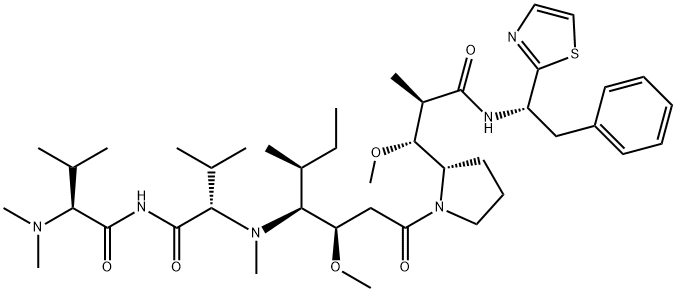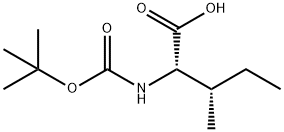Definition
ChEBI: Dolastatin 10 is a tetrapeptide that is isolated from the sea hare Dolabella auricularia. It is a potent anticancer agent which inhibits tubulin polymerization. It has a role as an animal metabolite, a marine metabolite, an antineoplastic agent, an apoptosis inducer and a microtubule-destabilising agent. It is a member of 1,3-thiazoles and a tetrapeptide. It is functionally related to a L-valine.
Biological Activity
dolastatin 10 is an antitumor agent [1].dolastatin 10 is a potent antimitotic polypeptide isolated from a marine animal and is developed as a potential antitumor agent. dolastatin 10 is found to have activity to inhibit tubulin polymerization with ic50 value of 1.2μm. besides that, it potently inhibits vincristine binding to tubulin with a ki value of 1.4μm in a noncompetitive manner. dolastatin 10 also shows moderate effect on enhancing the binding of colchicines to tubulin. in addition, dolastatin 10 has the inhibitory activity in tubulin-dependent gtp binding [1].in the cellular assay, dolastatin 10 shows activity against some human leukaemia, lymphoma and solid tumour cell lines (such as ovcar-3 and nsclc) with ic50 values ranging from 0.1nm to 10nm. it is currently tested in the
in vitro
Dolastatin 10 is a unique pentapeptide that isolated from the sea hare Dolabella auricularia . These in vitro data are quite comparable to those of Dolastatin 10 and Auristatin PE, each of which has GI < sub> 50 values of 10 ?5 -10 ?6 μg/mL (10 ?2 -10 ? 3 nM) against a similar minipanel of human cell lines. The antibody-drug conjugate (ADC) comprises the anti-CD30 monoclonal antibody cAC10 conjugated to the cytotoxic agent monomethyl auristatin E (MMAE), a synthetic analog of the tubulin polymerization inhibitor Dolastatin 10.
References
[1] bai r l, pettit g r, hamel e. binding of dolastatin 10 to tubulin at a distinct site for peptide antimitotic agents near the exchangeable nucleotide and vinca alkaloid sites. journal of biological chemistry, 1990, 265(28): 17141-17149.
[2] schwartsmann g. marine organisms and other novel natural sources of new cancer drugs. annals of oncology, 2000, 11(suppl 3): 235-243.

